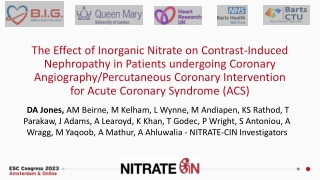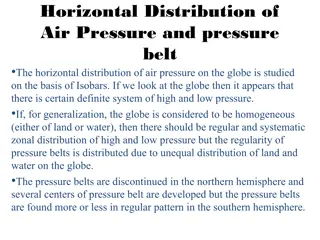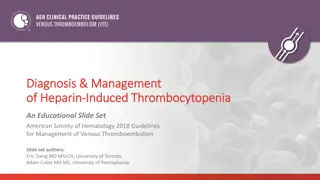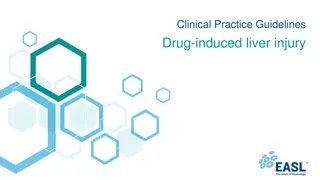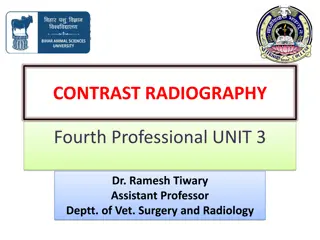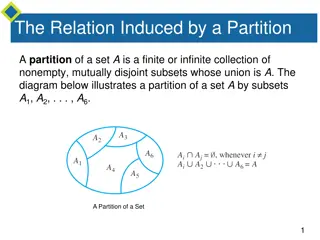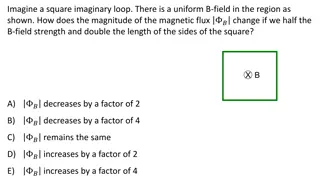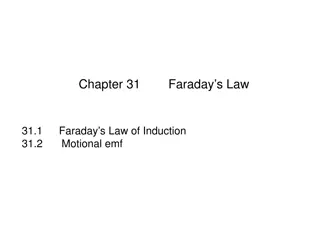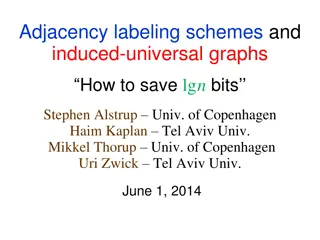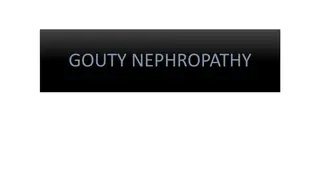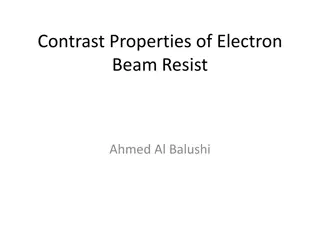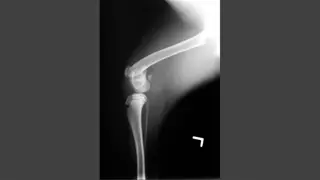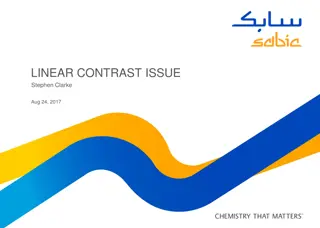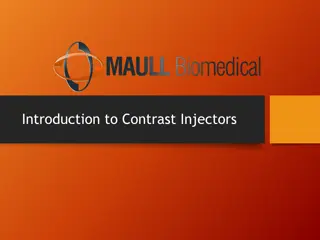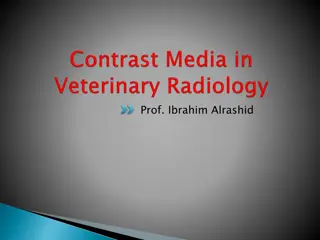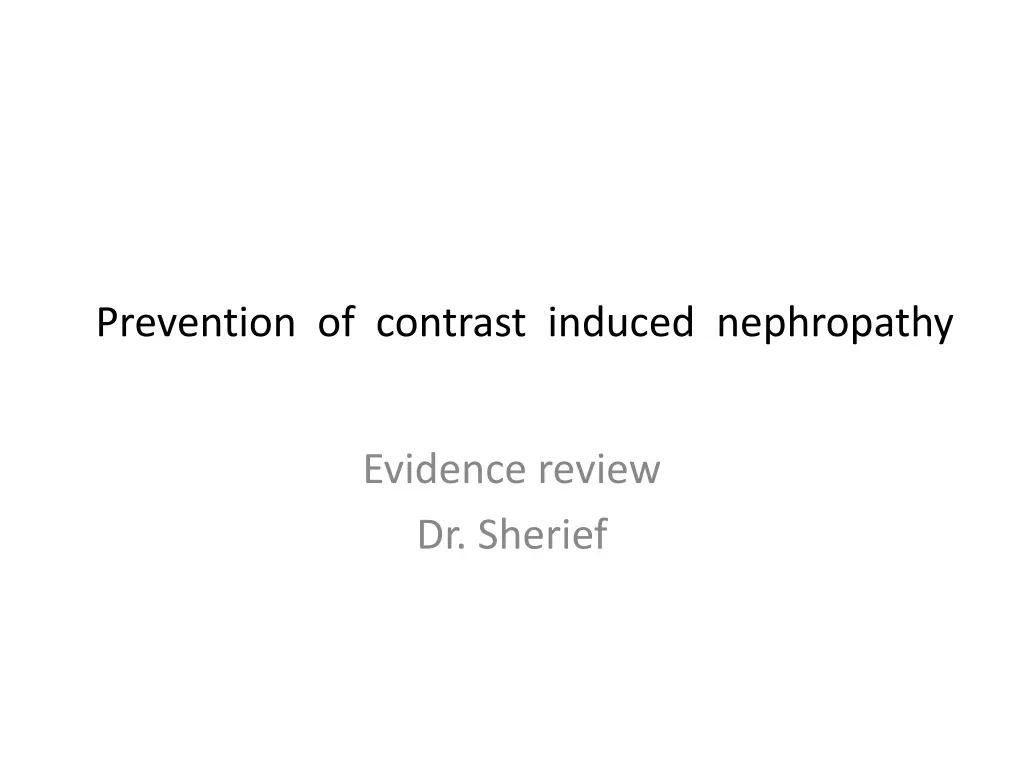
Contrast-Induced Nephropathy: Prevention Measures and Risk Factors
Explore evidence-based preventive measures for contrast-induced nephropathy (CIN) to reduce the risk of acute kidney injury post-radiocontrast media administration. Learn about predisposing factors, diagnostic criteria, and strategies to mitigate CIN-related complications. Discover the importance of fluid management, choice of contrast material, and pharmacotherapy in preventing CIN in at-risk patients undergoing imaging procedures.
Download Presentation

Please find below an Image/Link to download the presentation.
The content on the website is provided AS IS for your information and personal use only. It may not be sold, licensed, or shared on other websites without obtaining consent from the author. If you encounter any issues during the download, it is possible that the publisher has removed the file from their server.
You are allowed to download the files provided on this website for personal or commercial use, subject to the condition that they are used lawfully. All files are the property of their respective owners.
The content on the website is provided AS IS for your information and personal use only. It may not be sold, licensed, or shared on other websites without obtaining consent from the author.
E N D
Presentation Transcript
Prevention of contrast induced nephropathy Evidence review Dr. Sherief
Contrast induced nephropathy Reversible (usually) form of AKI soon after administration of radiocontrast media Non DM : 13% DM : 20% Usually no permanent sequelae (Dialysis in 0.5% 2.0%) Associated with adverse outcomes Aspelin P et al. Nephrotoxic effects in high-risk patients undergoing angiography. N Engl J Med 2003
CIN - Definition KDIGO definition CIN is defined when one of the following criteria is met Serum creatinine rises by 0.3mg/dl within 48 hrs Serum creatinine rises 1.5 fold from the baseline value Urine output is < 0.5ml/kg/hr for >6 consecutive hrs Trials : 0.5 mg/dL or 25 to 50% above baseline within 48-72 hrs
Predisposing factors Baseline serum Creatinine Acute MI Shock / LVEF Volume of contrast used DM Male gender CIN No CIN p In- hospital mortality 22% 1.4% <0.0001 1 yr mortality 12.1% 3.7% <0.0001 5 yr mortality 44.6% 14.5% Incidence and prognostic importance of acute renal failure after percutaneous coronary intervention, circulation 2002
What the clinical trials evaluated? End points : Small, transient elevations in the serum creatinine ? Dubious clinical significance 0.5 mg/dL or 25 to 50% above baseline CIN defined in this manner is associated with significant in-hospital and long-term mortality Rihal CS et al. Incidence and prognostic importance of acute renal failure after percutaneous coronary intervention. Circulation 2002 Dangas G et al. Contrast-induced nephropathy after percutaneous coronary interventions in relation to chronic kidney disease and hemodynamic variables. Am J Cardiol 2005
Prevention of CIN No specific treatment once CI-AKI develops Maintaining fluid and electrolyte balance
Preventive measures Choice of contrast material : selected low or iso-osmolal nonionic contrast agents Quantity of contrast : Use of lower doses of contrast Avoidance of closely spaced repetitive studies (within 48 -72 hrs) Avoidance of volume depletion/NSAIDs (increase renal vasoconstriction) Hydration and volume expansion : iv saline or sodium bicarbonate End organ protection with pharmacotherapy : Acetylcysteine / other agents
Contrast agents - Types Types of radiocontrast agents Iodinated radiocontrast agents Ionic or nonionic Variable osmolality First generation agents Ionic monomers Highly hyperosmolal (1400 to 1800 mosmol/kg) Ioxaglate - ionic low osmolal contrast agent Second generation agents Nonionic monomers (iohexol) Lower osmolality than the first generation agents Increased osmolality (500 to 850 mosmol/kg) compared with plasma
Contrast agents - Types The newest nonionic contrast agents Iso-osmolal (lower osmolality than "low osmolal" second generation drugs) Dimers with an osmolality of 290 mosmol/kg Iodixanol is the first such agent The nephrotoxic properties vary with the agents CIN : non ionic low osmolal or iso-osmolal << High osmolal agents The ionic low-osmolal agent ioxaglate - lower risk of contrast nephropathy Lautin et al. Radiocontrast-associated renal dysfunction: a comparison of lower- osmolality and conventional high-osmolality contrast media. AJR Am J Roentgenol 1991
Nonionic low osmolal agents Optimal renoprotective role of nonionic low osmolal contrast agents may vary with the clinical setting Used for the majority of radiologic procedures using intravascular contrast media Cost reductions Increased patient tolerability Decreased hypersensitivity reactions Lower incidence of contrast nephropathy in patients at risk
Direct comparisons between the various agents Which one to use?
Iohexol superior to diatrizoate Rudnick MR et al. Nephrotoxicity of ionic and nonionic contrast media in 1196 patients: a randomized trial. The Iohexol Cooperative Study. Kidney Int 1995 Prospective, multicenter, double-blind RCT 1200 patients undergoing CAG Iohexol Vs Diatrizoate Patients with a baseline creatinine >1.4 mg/dL Rise in the serum creatinine of 1.0 mg/dL (3% vs 7 %) P < 0.002 Greater benefit in diabetics (11.8 vs 27%)
Iodixanol superior to iohexol Nonionic iso-osmolal agents Iodixanol vs Iohexol 129 high risk patients undergoing CAG DM and CKD (mean serum cr. 1.5 mg/dL) CIN : 3 vs 26 % with iohexol p < 0.001 Aspelin P et al. Nephrotoxic effects in high-risk patients undergoing angiography. N Engl J Med 2003
Iso osmolal vs low osmolal McCullough PA et al. A meta-analysis of the renal safety of isosmolar iodixanol compared with low-osmolar contrast media. J Am Coll Cardiol 2006 16 double-blind, RCT n = 2,727 IOCM iodixanol vs LOCM Iodixanol LOCM P Maximum creatinine rise Overall 0.06 mg/dl 0.10 mg/dl p < 0.001 CKD 0.07 mg/dl 0.16 mg/dl p = 0.004 CKD + DM 0.10 mg/dl 0.33 mg/dl p = 0.003 Overall 1.4% 3.5% p < 0.001 CIN CKD 2.8% 8.4% p = 0.001 CKD + DM 3.5% 15.5% p = 0.003
Iodixanol = ioversol VALOR Trial - 2008 Iodixanol vs ioversol Prospective double blind trial 337 patients with stable CKD CIN: 21.8% vs 23.8% (p=0.78) [> 0.5 mg/dl increase 72 hrs] DM : Mean peak percentage change in creatinine was 12.9% vs 22.4% (p=0.01) No significant difference in CIN in CKD pts undergoing angiography Rudnick MR et al. Nephrotoxicity of iodixanol versus ioversol in patients with chronic kidney disease: the Visipaque Angiography/Interventions with Laboratory Outcomes in Renal Insufficiency (VALOR) Trial. Am Heart J 2008
Iodixanol = iopamidol Solomon RJ et al. Cardiac Angiography in Renally Impaired Patients (CARE) study: a randomized double-blind trial of contrast-induced nephropathy in patients with chronic kidney disease. Circulation 2007 Multicenter, double-blind RCT CKD (eGFR 20 to 59 mL/min) who underwent CAG / PCI
Iodixanol = Iopamidol Laskey W et al. Nephrotoxicity of iodixanol versus iopamidol in patients with chronic kidney disease and diabetes mellitus undergoing coronary angiographic procedures. Am Heart J 2009 Prospective multicenter double blind RCT 418 subjects Iodixanol vs iopamidol Median peak increase in SCr : 0.10 mg/dl vs 0.09 mg/dL (P =0.13) CIN : 10.5% Iodixanol : 11.2% Iopamidol : 9.8% P = 0.7 No significant difference in either peak increase in SCr or risk of CIN
Solomon R. The role of osmolality in the incidence of contrast-induced nephropathy: a systematic review of angiographic contrast media in high risk patients. Kidney Int 2005 17 studies 1365 patients CIN (overall) : 16.8% Multivariate logistic regression CIN : Iodixanol = Iopamidol (796 mOsm/kg) Iodixanol << Iohexol Iopamidol << Iohexol (despite similar osmolalities) Factors other than osmolality play a significant role in the pathogenesis of CIN
Reed M et al. The relative renal safety of iodixanol compared with low- osmolar contrast media: a meta-analysis of randomized controlled trials. JACC Cardiovasc Interv 2009 Meta-analysis 16 randomized trials CKD patients Iodixanol vs Iohexol (RR 0.19, 95% CI 0.07-0.56) Iodixanol vs other nonionic low osmolal contrast agents (RR 0.79, 95% CI 0.56-1.12)
Summary Iso-osmolal iodixanol vs low osmolal iohexol iodixanol Iodixanol vs nonionic low osmolal agents No difference Initial findings of superiority of iodixanol Represents an adverse effect of iohexol
What the guidelines say? ACC/AHA guidelines (2009) on PCI No to iohexol Use of either an iso-osmolal contrast agent or a low osmolal contrast agent other than iohexol or the ionic low osmolal agent, ioxaglate KDIGO guidelines (2012) low-osmolal or iso-osmolal rather than high osmolal contrast agents No reliable evidence upon which to base a recommendation for either low versus iso-osmolal agents
Patients with renal insufficiency Patients with moderate renal insufficiency (S.Cr 1.4 - 2.4 mg/dL) : Reduced incidence of CIN with nonionic, low osmolality agents low vs high osmolal agents CIN Rudnik MR et al 1995 3% vs 7% p < 0.002 Lautin et al 1991 7% vs 26% p = 0.001 Moore RD et al 1992 2% vs 15% p < 0.05 Barrett BJ et al 1992 3.8% vs 6.8% Harris KG et al 1991 2% vs 14% p < 0.05
Patients with normal renal function RCT 1196 patients undergoing CAG Patients were stratified into four groups: Renal insufficiency (RI) Diabetes mellitus (DM) Both absent (N = 364) RI -- ; DM + (N = 318) RI + ; DM -- (N = 298) RI and DM both present (N = 216) Diatrizoate vs iohexol Differences in nephrotoxicity between the two contrast groups were confined to patients with RI DM Little or no advantage with low osmolar agents in normal renal function Rudnick MR et al. Nephrotoxicity of ionic and nonionic contrast media in 1196 patients: a randomized trial. The Iohexol Cooperative Study. Kidney Int 1995
Contrast volume The prevalence of CIN correlates with contrast volume Lowest rates of CIN occur in patients receiving < 100 to 140 mL Volumes > 5mL/kg strongly predict nephropathy requiring dialysis Freeman RV et al. Nephropathy requiring dialysis after percutaneous coronary intervention and the critical role of an adjusted contrast dose. Am J Cardiol 2002 The primary benefit of nonionic contrast agents (LOCM/IOCM) is seen in high-risk patients (S.Cr 1.5 mg/dL or GFR <60 mL/min/1.73 m2), particularly in diabetics Second dose of contrast 48 hrs significantly increased risk of CIN Trivedi H, Foley WD. Contrast-induced nephropathy after a second contrast exposure. Ren Fail 2010 Independent predictors of CIN LVEF (P = 0.02) Contrast volume (P = 0.01) Gruberg L et al. The prognostic implications of further renal function deterioration within 48 h of interventional coronary procedures in patients with pre-existent chronic renal insufficiency. J Am Coll Cardiol 2000
Carbon dioxide : An alternative contrast agent Used alone or with small amounts of iodinated contrast Satisfactory imaging and procedural results with modern imaging technology (DSA) (Schreier DZ et al. Arch Surg 1996) No or little nephrotoxicity, cheap, non-allergenic Risk of neurotoxicity Injected close to the cerebral circulation Right-to-left intracardiac shunt Cannot be used for cerebrovascular imaging Limited to imaging below the diaphragm
Diuretics Solomon R et al. Effects of saline, mannitol, and furosemide to prevent acute decreases in renal function induced by radiocontrast agents. N Engl J Med 1994 78 patients Stable CKD (mean cr. 2.1 mg/dL ) awaiting CAG AKI : Lowest in the group treated with saline alone Mannitol was of no added benefit Randomly assigned to one of three regimens 0.45% saline at a rate of 1 mL/kg/hr for 12 hrs before and 12 hrs after Furosemide therapy slightly increased the risk (despite absence of volume depletion) CAG 0.45% saline + 25 g of iv mannitol (1 hr before procedure) 0.45% saline + 80 mg of iv furosemide (30 mins before CAG) AKI : rise in the serum creatinine of 0.5 mg/dL
Saline : superior to dopamine, mannitol Weisberg LS et al. Risk of radiocontrast nephropathy in patients with and without diabetes mellitus. Kidney Int 1994 50 patients (24 diabetics) Moderate CKD (mean creatinine 2.5 mg/dL ) awaiting CAG Randomly assigned to receive Saline Dopamine [2 mcg/kg/min] Mannitol [15 g/dL in 0.45% saline at 100 mL/h] ANP CIN : 25 % increase in S.Cr
Saline : superior to dopamine, mannitol Results : Saline hydration: 40 % incidence of renal dysfunction in DM and non- DM patients Dopamine, mannitol and ANP : 75 to 83% in diabetics Nondiabetic patients : No cases of contrast toxicity Mannitol - associated with significant complications
Forced euvolemic diuresis : harmful Majumdar SR et al. Forced euvolemic diuresis with mannitol and furosemide for prevention of contrast-induced nephropathy in patients with CKD undergoing coronary angiography: a randomized controlled trial. Am J Kidney Dis 2009 RCT 92 patients Moderate renal insufficiency (mean S.Cr 2.8 mg/dL ) Mannitol + furosemide vs placebo 500 ml 0.45% saline + 25g mannitol + 100mg frusemide AKI : 25% increase in S.Cr Result : 50% vs 28% p = 0.03 OR 3.73, 95% CI 1.12-12.38 There was no difference in net fluid balance between the groups
Minimize the risk of volume depletion in the setting of a forced diuresis (Briguori C et al. (REMEDIAL II) EuroIntervention 2011) Fluid management device RenalGuard system
REMEDIAL II Briguori C et al. Renal Insufficiency After Contrast Media Administration Trial II (REMEDIAL II): RenalGuard System in high-risk patients for contrast-induced acute kidney injury. Circulation 2011 Multicenter RCT 292 patients eGFR 30 ml/min/1.73m2 RenalGuard group : Hydration with saline and NAC controlled by RenalGuard system and frusemide Control : NaHCO3 and NAC CIN : 11% vs 20.5% OR 0.47 95% CI 0.24 0.92
MYTHOS trial Marenzi G et al. Prevention of contrast nephropathy by furosemide with matched hydration: the MYTHOS (Induced Diuresis With Matched Hydration Compared to Standard Hydration for Contrast Induced Nephropathy Prevention) trial. JACC Cardiovasc Interv 2012 170 patients CKD Furosemide with matched hydration vs standard iv saline hydration 250 ml iv saline followed by 0.5mg/kg of furosemide CIN : 4.6% vs 18% p = 0.005
Disadvantages of forced diuresis Concerns about high volume forced diuresis (even in the setting of carefully matched volume replacement) volume overload may ensue if isotonic saline is used to replace urine Urine generally has the tonicity of half normal saline following loop diuretics Increase in intravascular volume may increase the eGFR in patients undergoing forced diuresis Hypokalemia from forced diuresis may precipitate arrhythmia in a vulnerable population
Isotonic vs half normal saline The optimal iv solution (isotonic saline, 0.45% saline or isotonic NaHCO3) for prevention of CIN is unclear Isotonic saline was superior to 0.45% saline (Weisbord SD et al Clin J Am Soc Nephrol 2008) Mueller C et al. Prevention of contrast media-associated nephropathy: randomized comparison of 2 hydration regimens in 1620 patients undergoing coronary angioplasty. Arch Intern Med 2002 RCT 1620 patients Isotonic vs 0.45% saline (1 mL/kg/hr from the morning of the procedure and continued until 8 AM the next morning) Baseline S.Cr : 0.9 mg/dL in both groups
Isotonic vs half normal saline CIN : in S.Cr of 0.5 mg/dL within 48 hrs The overall incidence of CIN was 1.4% Significantly lower with isotonic saline (0.7 vs 2.0%) More pronounced benefit Diabetic patients (0 versus 5.5%) Use of > 250 mL of contrast (0 versus 3%) No difference for those with significant renal dysfunction (s.cr. >1.6 mg/dL) Saline : 14% 0.45% saline : 17% Important limitation : patients with underlying renal dysfunction are at increased risk for CIN
Saline superior to bicarbonate Trivedi HS et al. A randomized prospective trial to assess the role of saline hydration on the development of contrast nephrotoxicity. Nephron Clin Pract 2003 RCT Prolonged infusion of isotonic saline vs briefer infusions of isotonic NaHCO3 Saline : 1 mL/kg/h for at least 12 hrs prior to and after the procedure NaHCO3 : 3 mL/kg for 1 hr prior to and 1 mL/kg/h for 6 hrs after the procedure Lower rate of CIN with isotonic saline
Saline superior to bicarbonate koc F et al. Sodium bicarbonate versus isotonic saline for the prevention of contrast-induced nephropathy in patients with diabetes mellitus undergoing coronary angiography and/or intervention: a multicenter prospective randomized study. J Investig Med 2013 RCT 195 DM patients Saline Bicarbonate p Max. in S.Cr Overall - 0.03 0.02 0.014 Cr.Cl <60 - 0.08 0.03 0.004 CIN 5.9% 16% 0.024
Bicarbonate : superior to saline Trial No. Agents used CIN Merten GJ et al JAMA 2004 RCT 119 NaCl vs NaHCO3 1.7% vs 13.6% P = 0.02 Briguori C et al REMEDIAL Trial Circulation 2007 RCT 326 NaHCO3 + NAC NaCl + NAC 1.9% vs 9.9% P = 0.019 Recio-Mayoral A et al RENO Study JACC 2007 RCT 111 ACS pts NaHCO3 + NAC NaCl 1.8% vs 21.8% P < 0.001 Ozcan EE et al Am Heart J 2007 RCT 264 NaHCO3 NaCl NaCl + NAC P<0.007 (1 vs 2,3) P=0.03 (1 vs 2) P=0.05 (1 vs 3)
Bicarbonate : Non-inferior to saline Brar SS et al. JAMA 2008 Maioli M et al. J Am Coll Cardiol 2008 Alonso A et al. Am J Kidney Dis 2004 Vasheghani-Farahani A et al. Am J Kidney Dis 2009 Brar SS et al. Clin J Am Soc Nephrol 2009
Oral hydration (no salt) Increasing number of individuals receive contrast as outpatients 3 small trials have evaluated the effectiveness of oral hydration or salt loading in preventing contrast nephropathy Trivedi HS et al. A randomized prospective trial to assess the role of saline hydration on the development of contrast nephrotoxicity. Nephron Clin Pract 2003 53 patients Unrestricted oral fluids (no salt) vs normal saline at 1 mL/kg/hr for 24 hrs beginning 12 hrs prior to the procedure AKI : 35% vs 4%
Salt loading The two trials that included salt loading as part of the protocol showed no difference in outcome compared to intravenous saline: Taylor AJ et al. PREPARED: Preparation for Angiography in Renal Dysfunction: a randomized trial of inpatient vs outpatient hydration protocols for cardiac catheterization in mild-to-moderate renal dysfunction. Chest 1998 36 patients Serum creatinine 1.4 mg/dL Outpatient oral hydration followed by 6 hrs of iv 0.45% saline vs inpatient regimen of iv 0.45% saline No difference in the maximal change in creatinine between the two groups
Oral salt loading = iv saline Dussol B, Morange S, Loundoun A, et al. A randomized trial of saline hydration to prevent contrast nephropathy in chronic renal failure patients. Nephrol Dial Transplant 2006 153 patients CKD (mean S.Cr 2.2 mg/dL ) Salt loading with tablets vs iv saline Salt loading : 1 g/10 kg/day in 3 doses for 2 days before contrast Saline : 15 mL/kg for 6 hrs No difference in the incidence of CIN Safety and efficacy of oral hydration or salt loading for the prevention of contrast nephropathy remains uncertain

